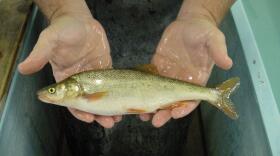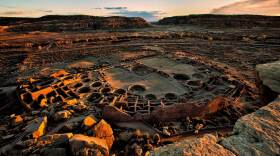The Grand Canyon, Wupatki National Monument and Sunset Crater Volcano are some of the geologic and cultural gems of the National Park Service. This summer, KNAU's Earth Notes series will highlight these, and other special places across the Southwest in honor of the Park Service's 100th anniversary. In the first installment of the series, we hear about efforts to protect sandstone panels of petroglyphs and pictographs at El Morro National Monument in New Mexico.
In west-central New Mexico, a huge sandstone monolith looms above a perennial pool of fresh water that’s sustained thirsty travelers for centuries.
Protected since 1906 as El Morro National Monument, the smooth rock face has recorded over two thousand inscriptions, petroglyphs, and pictographs. Together, they document a rich history: a cultural continuum from Ancestral Puebloans to the earliest Spanish explorers and American military expeditions, as well as other travelers.
But as with many of the National Park Service’s outdoor treasures, preserving these inscriptions is a challenge. Erosion and weathering take a toll, along with sun exposure and vandalism.
A project now underway has identified an even bigger threat: infiltration of moisture into the soft sandstone from below and above the carvings. A team from the University of New Mexico’s anthropology department at UNM’s Colorado Plateau Cooperative Ecosystems Study Unit is working to discover how water is breaking down and flaking away the rock, taking inscriptions with it.
Experts in geology, hydrology, archaeology, and preservation hope to learn what might be done to better protect this unique record of human history.
The problem is compounded by the fact that climate change has made El Morro wetter now than it’s been during the past 2,000 years. More water flows over the cliff, and increased moisture may be wicking into the sandstone face from the ground, speeding deterioration.
Park managers hope that an understanding of this process will better allow them to safeguard this irreplaceable outdoor archive for future generations.








